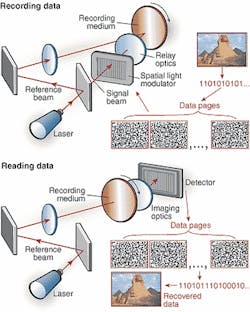Holographic technology handles data storage
According to market-research-firm IDC (Framingham, MA), implementation of storage devices is estimated to exceed 1.3 million Tbytes in 2003. As digital-video-recording applications increase, particularly in the professional sector, removable-storage-capacity needs will grow accordingly, providing market opportunities for holographic data storage.
In holographic data storage, light from a coherent laser source is split into a data-carrying signal and a reference beam. Digital data can be encoded onto the signal beam as it passes through a spatial light modulator that either blocks or transmits light. This encoded beam then interferes with the reference beam in a photosensitive recording medium and stores digital data pages as diffractive volume gratings.
The reference beam diffracts from the recorded gratings and reconstructs the stored array of bits, which are then projected onto a detector that reads the data in parallel. This parallel readout of data provides holography with its fast data-transfer rates. Varying the angle of incidence or wavelength of the reference beam enables many different data pages to be recorded in the same volume of material. These data pages are read out by applying a reference beam identical to that used during writing, a process that produces an enormous storage capacity.
At last month's annual National Association of Broadcasters trade show, InPhase Technologies (Longmont, CO) demonstrated what the company claims is the world's first holographic video-recording system—Tapestry. Based on more than eight years of research and development, conducted mostly at Bell Labs (Murray Hill, NJ), the Tapestry system includes both drive and media products. Volume shipments are targeted for 2004. Whereas future generations of Tapestry will provide terabytes of storage on a single disk, the initial write-once product is expected to record 100 Gbytes of video on a disk.
Polight Technologies (Cambridge, England) is also developing holographic-data-storage technology to capitalize on research by Stephen Elliott at the Cambridge University Chemical Laboratory (Cambridge, England). "The main reason why optical data storage has not yet been commercialized is due to a materials problem," he says. Interested companies are divided on the types of technology to use. While companies such as InPhase Technologies, Bayer AG (Leverkusen, Germany), and Aprilis (Maynard, MA) are opting for ferroelectric crystals or polymers, others, such as Polight, are using semiconducting glasses.
Although many companies are still tailoring suitable materials for holographic data storage, available products that use the technology are still, it seems, at least two years away. After suitable materials are found, their cost of manufacturing in large quantities will determine which company will emerge as the leader in this high-density data-storage market.

